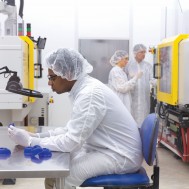Quality is the key factor in developing critical medical seals. Every seal must be free of contamination and compatible with various medical environments. To ensure that medical seals are safe for patient care, a certified cleanroom is necessary for manufacturing, testing and packaging products. Apple Rubber is home to a Class 10000, ISO 7 certified cleanroom for medical seal production.
Cleanrooms are designed to control product exposure to various pollutants, such as dust and airborne microbes. Contaminants are typically generated from five key components:
- Facilities
- People
- Tools
- Fluid
- Products
Medical seal production involves specific protocols for material preparation, manufacture, inspection, cleaning and packaging. This is to ensure these contaminant sources are avoided.
Manufacturing In a Cleanroom Environment
Inside Apple Rubber’s cleanroom, you can find injection molding machines, post-cure ovens, a fully automated ultrasonic parts cleaning system, as well as inspection and packaging zones. Individually, each of these processes must not introduce contamination onto the rubber component. Contamination prevention measures include:
- Cleanroom Environment: High Efficiency Particulate Air (HEPA) filters must constantly move clean, filtered air through the room. around the room. Fan Filter Units (FFU’s) are employed to move air down from the ceiling to the floor. Air flow, air changes, and particulate counts should be measured at documented intervals while rubber molding and packaging takes place.
- Post Cure Oven Atmosphere: Post cure is a batch process that more completely crosslinks the rubber material. It takes place in ovens that are supplied through HEPA filtered air. The quantity and placement of rubber components is controlled to assure adequate airflow around the parts. It’s recommended that a supply of fresh air is maintained into the post curing oven to prevent the formation of flammable gasses or siloxane mixtures.
- Equipment in Cleanroom: All equipment surfaces must be cleaned regularly. This includes molding presses, inspection stations, heat sealers, parts trays, and the clean room walls themselves. Everything is cleaned with a mixture of isopropyl alcohol and purified water.
- Ultrasonic Parts Cleaning: Medical grade rubber parts are cleaned just before they are packaged. Rubber components are placed into an ultrasonic parts washing apparatus that uses a surfactant and purified water to remove contaminants from the surface of the rubber components. Constant flow coupled with continuous monitoring of the water baths helps assure water quality.
The Importance of Purified Water
All water used to clean medical parts must be purified to meet strict standards. The exclusive use of purified water ensures that contaminants, including pyrogens, are not present and can therefore not become attached to medical device components. There are several standards to limit the levels of pyrogens present in purified water:
- The USP water for injection limit is 0.25 endotoxin units (EU) per milliliter (mL) of water
- The ASTM D1193 Grade A and Grade B endotoxin limits are 0.03 EU/mL and 0.25 EU/mL, respectively
Apple Rubber’s water purification system is capable of producing non-pyrogenic water. Our specification limit is 0.25 EU/mL with associated action and alert limits.
Inspection and Packaging Procedures
After medical seals are molded, stringent inspection procedures must be followed. Visual attribute inspection of the rubber parts scrutinizes all surfaces for any blemish. These imperfections are documented and dispositioned based on AQL sampling techniques. To maintain rubber component integrity, always make sure to use double poly bag packaging so the outer layer can be shed before placing the packages into your cleanroom.
Want to learn more about manufacturing medical seals?
Contact an engineer today to answer any questions or request a quote.
